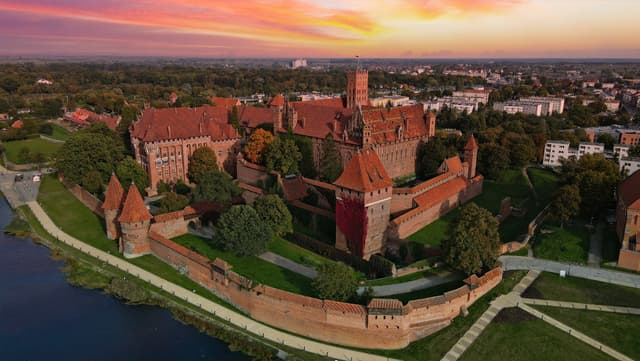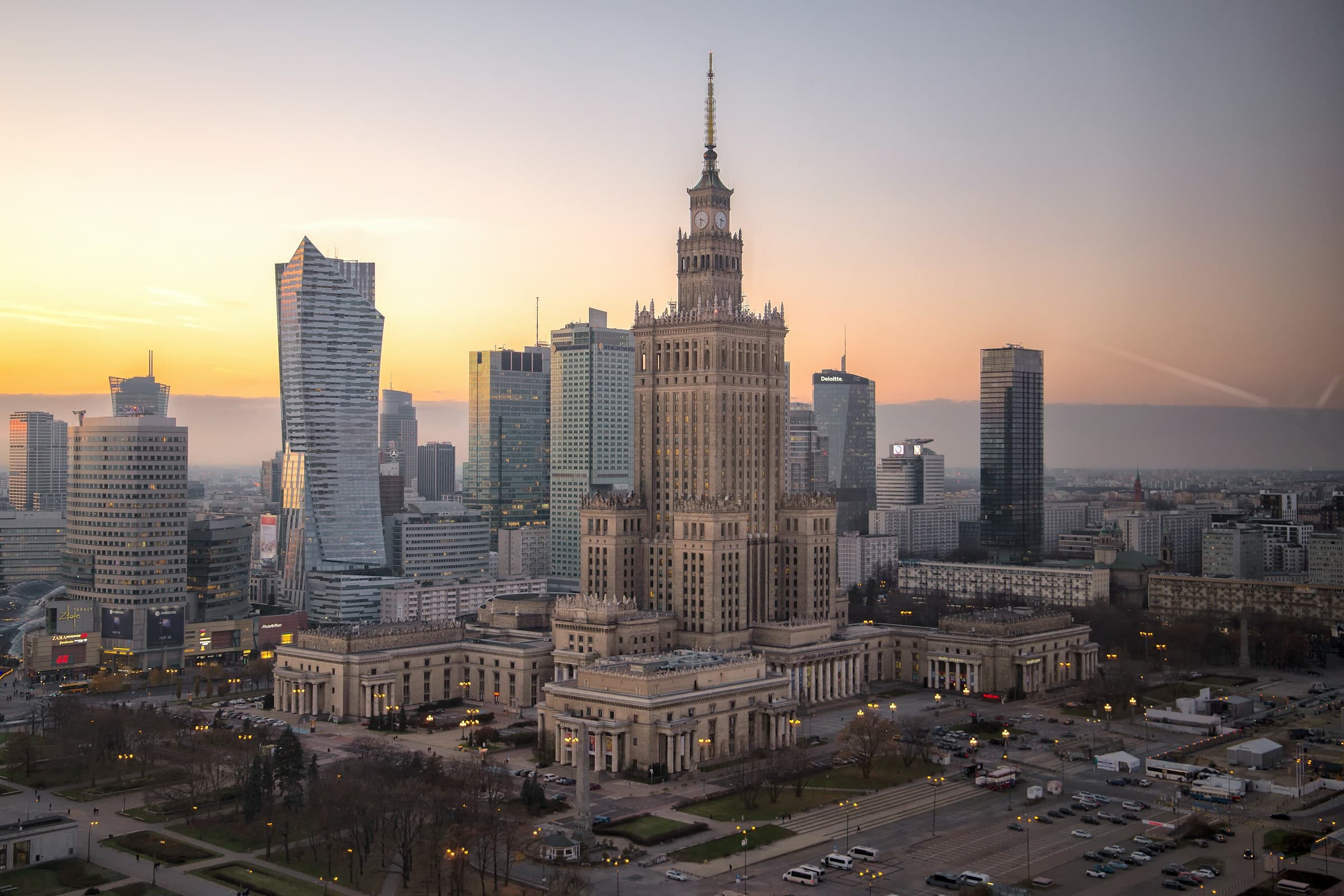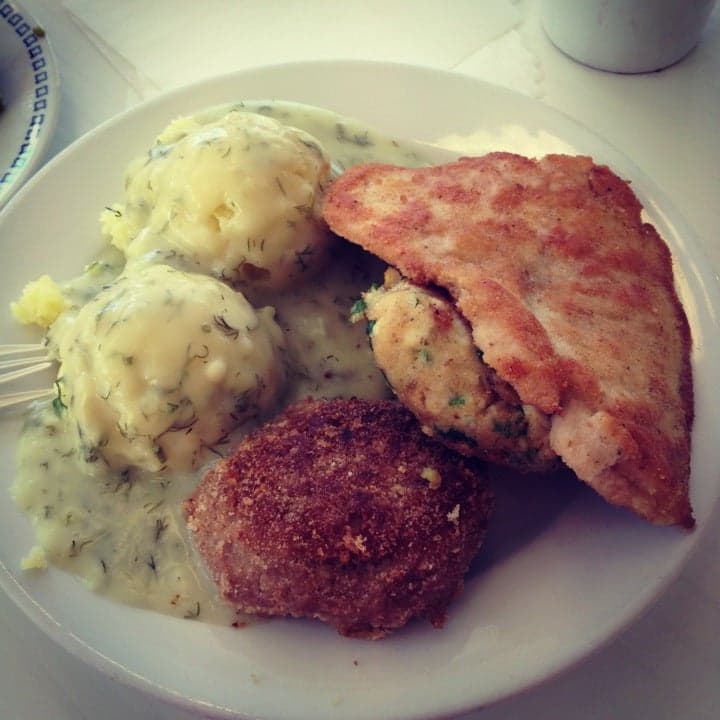Malbork vs. Toruń
Malbork
Malbork is a small city in northern Poland, but what makes it stand out is its enormous, medieval brick castle—one of the largest in the world. Built in the 13th century by the Teutonic Knights, the castle was more than just a fortress; it was the headquarters of a powerful religious and military order that controlled vast territories in the region. Today, Malbork Castle is a UNESCO World Heritage Site and a must-see for history lovers, with its towering walls, grand halls, and a fascinating museum that showcases medieval artifacts, weapons, and amber craftsmanship. Walking through its courtyards and chambers, you get a real sense of what life might have been like in the Middle Ages. The city itself is located along the Nogat River, about an hour’s drive from Gdańsk. While Malbork is mostly known for its castle, it has a peaceful, small-town charm. The streets are lined with trees, there are cozy cafés and restaurants serving Polish food, and you can still see traces of the city’s P...
Toruń
Toruń is one of Poland’s most fascinating and well-preserved cities. Sitting on the banks of the Vistula River, it’s a place where medieval charm blends seamlessly with a lively modern atmosphere. Unlike many Polish cities, Toruń was spared destruction during World War II, which means its historic Old Town remains intact, offering visitors an authentic glimpse into Poland’s past. In 1997, it was recognized as a UNESCO World Heritage Site, a testament to its architectural and cultural significance. A Medieval Treasure Stepping into Toruń’s Old Town is like walking through a storybook. Gothic churches, red-brick merchant houses, and cobblestone streets create a timeless atmosphere. The city was a powerful trading center in the Hanseatic League, and its wealth is reflected in landmarks like the Town Hall, an imposing structure at the heart of the city, and the beautifully preserved medieval walls. Many buildings date back to the 14th and 15th centuries, making Toruń one of Poland’s be...
Reviews
Reviews
Reviewed on 2/27/2025
| Item | Votes | Upvote |
|---|---|---|
| Malbork has a huge medieval castle | 1 |
| Item | Votes | Upvote |
|---|---|---|
| No cons yet, would you like to add one? | ||
| Item | Votes | Upvote |
|---|---|---|
| World capital of gingerbread | 1 | |
| Birthplace of Copernicus | 1 | |
| Beautiful medieval architecture | 1 |
| Item | Votes | Upvote |
|---|---|---|
| No cons yet, would you like to add one? | ||
Frequently Asked Questions
Malbork is renowned for its enormous medieval castle, which is one of the largest in the world and a UNESCO World Heritage Site. It offers a deep dive into the medieval era with its historical reenactments and artifacts. In contrast, Toruń is also rich in history, featuring well-preserved medieval architecture and being the birthplace of Nicolaus Copernicus. While Malbork focuses on the medieval military history of the Teutonic Knights, Toruń provides a broader cultural experience with its intact Old Town and contributions to science. The choice depends on whether you prefer a castle-centric experience or a blend of history and culture.
Toruń has a more vibrant cultural scene compared to Malbork. It is home to Nicolaus Copernicus University, which brings a youthful energy and numerous cultural events, including festivals celebrating theater, film, and music. The city's lively atmosphere is enhanced by its riverside setting and the presence of students. Malbork, while rich in history, is quieter and primarily focused on its castle and historical reenactments, making Toruń the better choice for those seeking a dynamic cultural experience.
Toruń is often considered better for food lovers, particularly because of its famous gingerbread (pierniki), which has a long-standing tradition in the city. Visitors can explore the Museum of Toruń Gingerbread and even participate in making their own. While Malbork offers traditional Polish cuisine in its cozy cafés and restaurants, it does not have a specific culinary highlight like Toruń's gingerbread. Therefore, if you're looking for a unique food experience, Toruń would be the preferable choice.
Malbork is known for its enormous medieval brick castle, which is one of the largest in the world. Built in the 13th century by the Teutonic Knights, the castle serves as a UNESCO World Heritage Site and features grand halls, towering walls, and a fascinating museum showcasing medieval artifacts.
The main pro of visiting Malbork is its huge medieval castle, which offers a unique glimpse into history and architecture. However, there are no significant cons listed by visitors, making it a generally favorable destination for history lovers.
Besides visiting the castle, visitors to Malbork can take a boat trip on the Nogat River for a unique view of the castle, rent a kayak for an active adventure, or explore the surrounding countryside filled with fields and forests. The city also features a large park and a dinosaur-themed amusement park, which is great for families.
The best time to visit Malbork is during the summer when the city hosts the 'Siege of Malbork' festival. This event features a large-scale reenactment of a 15th-century battle, complete with knights in armor, sword fights, and a medieval-style market.
Malbork has a peaceful, small-town charm with tree-lined streets, cozy cafés, and restaurants serving Polish food. The city retains traces of its Polish and German heritage in its architecture, making it a pleasant place to explore.
Toruń is known as the world capital of gingerbread, the birthplace of the famous astronomer Nicolaus Copernicus, and for its beautiful medieval architecture. The city is a UNESCO World Heritage Site, showcasing well-preserved Gothic churches, red-brick merchant houses, and cobblestone streets.
Pros of visiting Toruń include its status as the world capital of gingerbread, the historical significance as the birthplace of Copernicus, and its beautiful medieval architecture. There are currently no cons listed for visiting Toruń, making it an appealing destination for travelers.
In Toruń's Old Town, visitors can see stunning Gothic churches, the impressive Town Hall, and the Leaning Tower, a medieval defensive structure. The area is filled with cobblestone streets and beautifully preserved buildings dating back to the 14th and 15th centuries, providing a glimpse into Poland's rich history.
Nicolaus Copernicus is significant in Toruń as he was born there. His birthplace has been turned into a museum where visitors can learn about his contributions to astronomy, particularly his heliocentric theory, which revolutionized our understanding of the solar system. A statue of Copernicus also stands in the main square, commemorating his legacy.
The Museum of Toruń Gingerbread is dedicated to the city's famous gingerbread tradition, which dates back to the Middle Ages. Visitors can learn about the history of gingerbread, see old baking molds, and even participate in workshops to make their own gingerbread using traditional methods.
Toruń has a lively and youthful atmosphere, largely due to the presence of Nicolaus Copernicus University. The city hosts various cultural events, festivals, and has numerous cafes and bookshops, creating a dynamic environment. The riverside setting along the Vistula River adds to its charm, especially during the summer months.





















